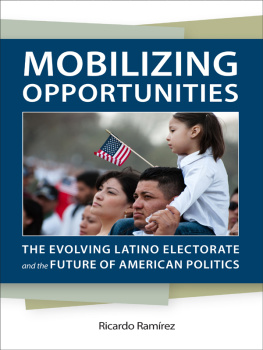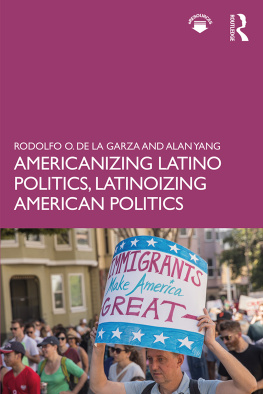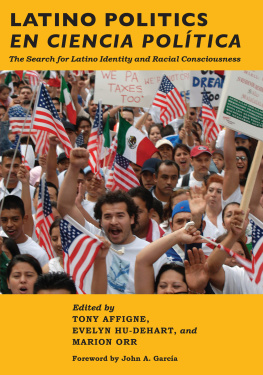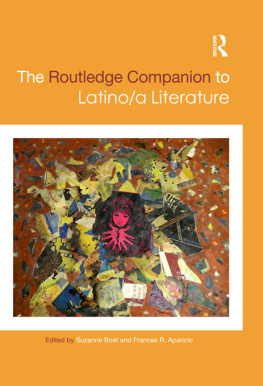FIGURES OF THE FUTURE
Figures of the Future
Latino Civil Rights and the Politics of Demographic Change
Michael Rodrguez-Muiz
PRINCETON UNIVERSITY PRESS
PRINCETON AND OXFORD
Copyright 2021 by Princeton University Press
Princeton University Press is committed to the protection of copyright and the intellectual property our authors entrust to us. Copyright promotes the progress and integrity of knowledge. Thank you for supporting free speech and the global exchange of ideas by purchasing an authorized edition of this book. If you wish to reproduce or distribute any part of it in any form, please obtain permission.
Requests for permission to reproduce material from this work should be sent to
Published by Princeton University Press
41 William Street, Princeton, New Jersey 08540
6 Oxford Street, Woodstock, Oxfordshire OX20 1TR
press.princeton.edu
All Rights Reserved
ISBN 978-0-691-19946-7
ISBN (e-book) 978-0-691-20590-8
Version 1.0
British Library Cataloging-in-Publication Data is available
Editorial: Meagan Levinson and Jacqueline Delaney
Production Editorial: Brigitte Pelner
Production: Erin Suydam
Publicity: Kate Hensley (US) and Kathryn Stevens (UK)
Copyeditor: Anita OBrien
Jacket Credit: Shutterstock
In honor and in memory of my motherNellie B. Muizmy first and fiercest teacher
There is no human science of the future. There is only faith in the future; and among the forces which combine to bring this future into being, the faith in its coming is one of the most effective.
HENDRIK DE MAN
ILLUSTRATIONS
.Projecting Majority-Minority infographic
.Expanding Latinidad infographic
.Its Your Turn in the Sun infographic
.Respeto-Futuro-Poder flyer
.Fuertes with the 2010 Census comic
.Fuertes with the 2010 Census comic
.This Is How Jesus Was Born poster
.Los U.S.A. infographic
.Lets Put Those Numbers to Use infographic
.Hispanics in the U.S. infographic
.Todos a Votar comic
.50,000 Latinos infographic
.Election Day 2012
.Historic Latino Vote Determines Election
.Demographic Meteor Hits GOP cartoon
.LULAC on Capitol Hill
.NHLA 2016 Policy Agenda press conference
.NHLA White House rally
.Latinos in 2060 infographic
.Stand Up for Our Community poster
ABBREVIATIONS
| Center for Community Change |
CHCI | Congressional Hispanic Caucus Institute |
LCLAA | Labor Council for Latin American Advancement |
LULAC | League of United Latin American Citizens |
MALDEF | Mexican American Legal Defense and Educational Fund |
| Mi Familia Vota |
NALEO-EF | National Association of Latino Elected and Appointed Officials Educational Fund |
NCLR | National Council of La Raza |
NHLA | National Hispanic Leadership Agenda |
NILP | National Institute for Latino Policy |
NLIRH | National Latina Institute for Reproductive Health |
SEIU | Service Employees International Union |
PREFACE
Ages ago, in 2001, long before I began writing this book, and well before I came to see population as politics, I wrote this sentence: Latinos make up 31 percent of the total school population. I was in my early twenties, a first-generation Puerto Rican undergraduate at Northeastern Illinois University. By the time I had enrolled, this former teaching college on Chicagos north side was a Hispanic-serving institution. No doubt, this federal designation was a legacy of the Puerto Rican/Mexican/Latinx student and community activism that opened up its doors. Yet much to my dismay, while Northeastern reaped financial gain from this status, it stubbornly resisted making its source a priority: there was no Latino cultural center on campus, the Latino Studies programthen called Mexican/Caribbean Studieswas on life support, Latino faculty members were few and far between, and Latino students rarely crossed the stage at graduation.
Alongside other frustrated students, I helped launch what became known as the Status of Latinos campaign. We searched for demographic statistics to help us prove the existence of a large but underserved student population. By juxtaposing the size of the Latino student population with the minuscule number of Latino faculty, graduates, courses, and services, we believed we could shame university administrators and catalyze students into action. We all but plastered the campus with flyers exclaiming our 31 percent figure, our proof that Latino students constituted one-thirdand an increasingly growing portionof the student body.
Those days are long gone, but writing this book has forced me to return to those past efforts and make sense of them in a new light. I dont think my comrades and I ever discussed the tactical decision to moor our arguments to demographic data. In retrospect, our use of numbers was, at least for us, a somewhat odd choice. We did not invoke demographic data to demand freedom for Puerto Rican political prisoners or an end to the U.S. bombing of the island of Vieques, the stock in trade of anticolonial Puerto Rican activists at the time. Nor were we leveraging numbers to speak about the conditions and contributions of undocumented people or advocate for the expungement of criminal records. Yet from another angle, our turn to demographic statistics was not all that unexpected. Like our contemporaries at the time, we inhabited a political and cultural horizon in which statistical facts were trusted and valued, and in which talk of Latinos was ubiquitous. We heard from all corners that the Latino population was on the verge of becoming the countrys largest minority group. Journalists and pundits variously celebrated and fretted about the Hispanicization and Latinization of American cities, music, cuisine, and politics. With its national and local inflections, all this talk drew on a parade of figures from the census in 2000. In some form or another, we absorbed this demographic conversation, in the process encountering the categories and claims-making tactics we ourselves came to adopt. As I later contemplated, an earlier generation of student activists fought, even risked expulsion, for a campus center named after the Latin American revolutionaries Emilio Zapata and Pedro Albizu Campos. Our group, instead, earnestly requested a Latino cultural center. Something had transpired over the decades that placed such distance between otherwise similar demands.
For me, at the time, the proliferation of data and discourse about Latino demographics and my own contingent embrace of Latino as a meaningful political identity prompted no reflection. That would come later, in 2006, when historic marches shook cities across the country to successfully oppose a repressive anti-immigrant congressional bill, the Border Protection, Anti-terrorism, and Illegal Immigration Control Act (H.R. 4437). Often referred to simply by the name of its chief sponsor, Representative James Sensenbrenner (R-WI), the bill sought to criminalize undocumented immigration and charge any individual or organization convicted of assisting undocumented immigrants with a felony. The upheaval took place as I was settling into life as a graduate student at the University of Illinois-Chicago. Two of my mentors, Nilda Flores-Gonzlez and Amalia Pallares, invited me to join an interdisciplinary research project on the sources of these unexpectedly massive local mobilizations. I chose to explore why Puerto Rican elected officials and community activistswith access to U.S. citizenshipwere actively involved in immigrant rights. Seeing how this solidarity was bonded to desires to build a Latino Agenda, I wondered: How have heterogeneous Latin Americanorigin groups come to be imaginedand to some extent imagine themselvesas part of a panethnic whole? What forces have been at play and what have been the consequences?







